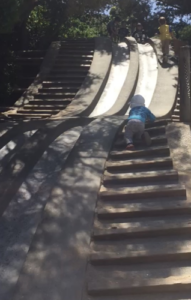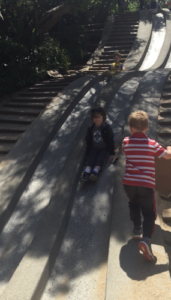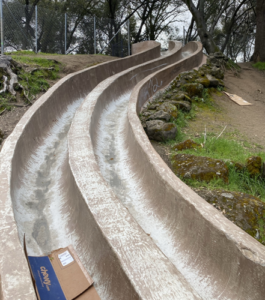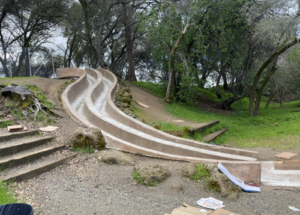Mountain Lake Park, San Francisco
I recommend starting your concrete slide tour here. This park has a humble slide, but a solid one, which, like all the others you’ll find in this city, has miraculously survived safety-minded playground renovations over the years. (Concrete slides are not safe. You can burn your skin, break a bone, crack your head open if you’re not careful. Try to be careful.)
This slide is the northernmost one in San Francisco. We’ll be working our way down. We’ll be working our way into a loop of sorts. We’re starting with a slide I never visited as a child. When I go to this park, I’m not assaulted by nostalgia. I can see the slide for what it is, see the park for what it is, nice and modern, a kidney-shaped playground surface in shades of blue, yellow, and green, a climbing wall pimpled with red handholds next to the slide. It’s not a palimpsest, all the old equipment, all the old stories, creaking beneath the surface. A good place to begin.
There’s usually a stash of cardboard near the base of any concrete slide you’ll visit, left behind by other sliders to help smooth your ride and prevent road rash (or they’re too lazy to recycle it). But you’ll probably want to bring your own. They say the virus can’t survive on surfaces for very long, but better to be safe than sorry, right? As safe as you can be on a concrete slide. I have a stack of cardboard in my trunk for this very purpose—sides of boxes from Target and Hello Fresh and whatever that wine club is called. We’re all ordering so much more online these days—you should have plenty of cardboard. If you want to go extra fast, you can tape or staple some wax paper to the bottom of the board. And don’t forget to mask up (even if you are vaccinated) and bring plenty of hand sanitizer—you want to be a slider, not a spreader!
This slide is short and wide, for those who prefer girth instead of length. (As you can see, this is not a guide for children.) It’s a great entry point into your concrete slide journey, this quick, smooth swoosh.
Koret Children’s Quarter Slides, San Francisco (Golden Gate Park)
Our next stop, Golden Gate Park, is one of the most beautiful places on earth, and its Koret Children’s Quarter is one of the oldest playgrounds in the country. It still features the original 1914 carousel (populated with ostriches, giraffes, sea monsters) but that’s not why you’re here. You’re here for the slides.

This side-by-side pair of concrete slides, built into the side of a hill in the 1970s, is long, sleek, and elegant, with a gentle curve halfway down, like an attenuated vertical tilde. The slides are flanked by wide concrete steps, creating a beautiful symmetry; no handrails, just low sculptural concrete. Very mid-century. The steps take a lot of breath to climb, and you might be tempted to take off your mask, but don’t (unless you need to use your inhaler and no one else is within six feet). Hopefully, not many people are here. Hopefully, any people who are here are being good citizens. Hopefully, they’ll see you’re being a good citizen, too, and leave you alone.

You lay your cardboard on the top of the slide, and you think about what the cardboard used to hold—the ingredients for turkey tetrazzini, say, or melatonin and the bread pans you still haven’t used yet, or a case of cabernet. Then you lower yourself onto it and let gravity do its work. You scream all the way down.
By the way, did you know this playground used to have different sections for boys (a ball field) and girls (a croquet lawn)? It was then called Sharon’s Quarter for Children, and older boys and men were not permitted. I’m glad my brother didn’t know this.
Hilltop Park, San Francisco
Our next stop is the last in the city (at least for now). You may ask: Why are there so many concrete slides in San Francisco? I wish I could tell you. My research has turned up nothing. Your guess is as good as mine.
Head over to the Bayview neighborhood to find Hilltop Park. You might know it for its eighty-foot-long slanted concrete sundial—it looks a bit like a slide itself, but trust me, it’s not. If you knew this sundial from way back when, you could be surprised to discover it was painted bright yellow during renovations; it looks kind of like a Calder sculpture now. You may also know Hilltop had the first skatepark in the city. My brother loved that skatepark. He really wanted a board after we moved to San Francisco—so many hills! Our parents refused—so many hills!—but he used his allowance to buy one himself and came here pretty often. No matter how much time he spent doing ollies and kickflips, he made time to go on the slides with me.
Hilltop has a single and a double. The latter is like the one at Golden Gate Park, but not nearly as stylish. It doesn’t have the same swerve, and it doesn’t have built-in steps—there’s a concrete ramp between the single and double slides, with large ugly rocks set into the ground on either side of it, making for a less congruent design. Honestly, the slides here look a little dumpy compared to those at Golden Gate. Perhaps it would have made sense to come here first—less anticlimactic that way—but then we’d have to backtrack to get to our next stop. One nice thing about Hillside is that the double slide has a smooth concrete arc over the top of it. My brother would sometimes sing “Somewhere Under the Rainbow” before we slid down side by side.
Brigadoon Park, San Jose
Do you know the way to San Jose? (Imagine me singing this, even though you don’t know what my voice sounds like.) It’s about an hour’s drive from Mountain Lake Park—an hour and one minute, according to Google Maps. I’m structuring this tour as if you’re going to do it all in one day, slide to slide to slide, but you don’t have to do that. Pace yourself as needed.
Like Mountain Lake, Brigadoon also has a single and a double. Perhaps they were designed by the same person, or one was inspired by the other? Either way, the double doesn’t have an overhanging arc, and there’s a large field of concrete sloped between the slides, kind of like a rough slide in itself. It’s pretty depressing-looking, actually. It makes me think of Soviet architecture, stark and dour.
My brother lived in San Jose for a while, after my parents kicked him out and a friend got him a job as a janitor at Cisco. I didn’t have a driver’s license yet, or money, or awareness of how to get anywhere, or the courage to figure out how, or I would have visited. Maybe even moved in with him. I hope he visited this slide, bleak as it is—it was on his list, but he didn’t strike through any of the locations, so it’s hard to say. I know for sure he went to at least four. I hope he had a chance to go to all of them. I hope I’m retracing his steps.
Codornices Park, Berkeley
In a wild coincidence, this park is one hour and one minute away from Brigadoon Park—I love the symmetry of that (kind of like the symmetry of the slides in Golden Gate Park). The single slide is in a shady area, like something out of a fairy tale. It curves under the canopy of a huge old oak; the stone steps leading to the top of the slide are built around the tree’s thick trunk. The design of this slide is graceful and organic, flowing with the landscape. It’s not the fastest, but the sides are higher in some places than in others, rising along the final bend like a wave with a lip—watch out for skinned elbows!
This park is near the rose garden—if you’re not racing to the next slide, you might want to walk through the tunnel that runs beneath the street and literally stop to smell the roses. Doing so may be important for your well-being, but it may also make you think of how your brother made you rose hip tea from the roses outside his apartment building (this was after you had your driver’s license, plus he had moved to the Castro, so it was easier to get to him). He told you rose hips were good for the skin (you tried not to take this personally—you had some acne that made you feel self-conscious), that they boosted immunity and helped the heart. He couldn’t drink them anymore, he told you—they were contraindicated with lithium. Anyway, he didn’t need more hips—the T he was finally taking was helping to narrow his hips, turn them into hips that felt more like his own.
Dorothy Bolte Park, Berkeley
The Berkeley hills are full of parks—Dorothy Bolte is only six minutes away from Codornices, and there’s another park between them (Indian Rock—no concrete slide there). It’s another lovely arboreal park. The single slide doesn’t feel quite as fable-like as the one at Codornices, maybe because the green metal bar that’s been placed over the top of it feels like something you’d find on a newfangled plastic slide. But this slide is steeper and faster and will give you more of a workout to get back to the top. (I do recommend more than one run for each slide on this tour—the first is just for the rush of it; after that, it’s to notice all the nuances.) The sides of this slide are also pretty high, so be sure to also tuck your elbows in here as well.
My brother dreamed of going to UC Berkeley. He loved the activist history of the place. He would have studied political science, he told me, or maybe architecture. He had a dream of building a house, a big modern house with a concrete slide inside it, next to the stairs. But he never finished high school after he came out as trans to our parents and they kicked him out. They never stopped calling him by his dead name when they spoke of him, never stopped calling him their daughter. He talked about getting his GED, about going to college someday, but that never came to pass.
Lincoln Estates Park, Roseville
The next stop is an hour and thirty-two minutes away. Another double slide, sort of a cross between Codornices (nice organic curves, nice trees) and Brigadoon. The dirt around the slides looks desolate. For some reason, the cardboard strewn about here looks more forsaken than it does elsewhere, too. But there is a kind of intimacy to this double slide that the others don’t have, which is strange because the divider separating the two sides is higher than any other double we have visited along the way. Perhaps it’s the sinuousness of these slides, like snakes undulating together. It made me a little uncomfortable, to be honest. I refuse to go on the slide when anyone else is nearby.

Don’t worry about being assaulted by roses and their accompanying memories in Roseville—this town is not full of the flowers, although apparently wild roses do grow along the ravine. The place used to be named Junction—it’s where the California Central and California Pacific tracks crossed. Then it became Roseville Junction, then just Roseville. There are many different stories about the origin of the name; my favorite has to do with two railroad men fighting over a woman named Rose. Still, whatever the real story may be, please remember the name changed over time. Changes are important. Names are important.

Barry. My brother’s name was Barry.

Hillside Park, Rancho Cordova
The newest concrete slides in Northern California, at least the newest on Barry’s list, are thirty-seven minutes away. Built in 2014, the two single slides, a couple of feet apart on a hill made of green and blue rubber, are geared more for young children than for adults—they’re pretty short and not very steep. Still, they’re worth a stop, even just to look at them. These slides have a unique feature, a little round basin at the bottom of each one, like the bowl of a spoon. This makes for a graceful dismount. No cardboard necessary on these babies. There’s also some interesting texturing on the outer sides that makes the concrete look almost like wood. I prefer smooth concrete but this is a nice touch, and of course, I’m thrilled to know concrete slides are still a part of modern playground design, even if they’re more safety-minded now. I’m sure Barry was thrilled about this, too.
Slide Hill Park, Davis
It will take you thirty-eight minutes (near symmetry with the last trip) to get to this next stop, the place where it all began—the breeding ground, ground zero, of our lifelong obsession with cement slides. Barry and I grew up in Davis, close to Slide Hill Park. The park has a pool and we spent plenty of time in the water, but we spent even more time on the slide. We were really into Harry Potter as kids; maybe you’ve noticed there are lots of stone slides in those books. We’d pretend the slide was the slide that went from the bathroom to the dungeons (“Watch out for the basilisk!” we’d scream) or the one that whooshes you to the tunnel that goes to Hogsmeade (“Butterbeer, here we come!”). Or it was the Hogwarts stairs playing pranks and flattening themselves into a slide (“Silly stairs!”). I was always Hermione and Barry was always Harry (in fact, he crafted his name out of Harry and the first letter of his dead name). When She Who Must Not Be Named revealed herself to be a TERF, it killed Barry. Not the way the virus killed Barry; not the way I was worried Barry would kill himself several times over the years; not the way I was worried some hate-filled stranger was going to kill Barry, but still, it killed him in its own way. He almost considered changing his name again, but by then, Barry was as much a part of him as his own liver.

The slide used to have two humps halfway down, which divided it into three sections, the only triple slide I know. But so many kids got hurt, they shaved the humps down to make one wide slide. Kind of like top surgery, now that I think of it. The slide resembles the one at Mountain Lake Park, but it’s a bit rougher around the edges, less prettied up. I like it that way. It makes me think our molecules might still be here from all our various abrasions. It makes me think I can breathe in some of Barry’s atoms still whirling through the air.
Depending on when you visit Slide Hill, you may see a trebuchet being assembled and put into action. You may see people dressed in armor, or various objects being hurled. You may watch pumpkins fly and wonder if that’s a metaphor for something, for letting go, maybe, or for trying to fly and crashing to the ground. You may tell yourself not to impose metaphors on everything, especially on slides, which have such negative connotations (going downhill, etc.). You may try to focus on the rush, the thrill, not all the things it can mean to plummet (watching vitals plummet over FaceTime, feeling your heart plummet when your brother’s partner hands you the list of all these slides with a header indicating Barry wanted to visit them with you). You may remember Slide Hill is an Open Container Ordinance area. You were way too young to take advantage of this when you lived in Davis—you’d never had a sip of alcohol in your life, didn’t know what “Open Container Ordinance” meant. You may be tempted to buy a bottle of wine and spend more time here, sitting and drinking and breathing in atoms, but you have one last stop to make.

Seward Mini-Park
For our final destination, we will return to San Francisco, an hour and twenty-three minutes away. Make sure you get an early start if you want to do this tour all in one day—the Seward Mini-Park closes at 5:00 pm, a metal gate locked over the slides. Also, make sure you don’t do this tour on a Monday, the only day of the week the Seward Mini-Park is closed. Also, be sure to find safe places to use the bathroom and eat as you go from slide to slide. (I recommend packing food and disposable gloves, along with your mask and hand sanitizer. And maybe an adult diaper if you really don’t want to use public facilities, but that’s up to you.)
The Seward Mini-Park is a hidden jewel tucked into a residential area behind Castro Village. The land was supposed to be developed into a big apartment complex, but the neighbors stopped it: two different projects, two different times. When a third developer tried to get the lot, neighbors held a sit-in to block the bulldozers and prevailed again. San Francisco Rec and Park ended up buying the land, and the steep, curvy, double concrete slide was built in 1973, the design of a fourteen-year-old girl who won a contest judged by the sculptor Ruth Agawa. Just goes to show you—concrete slides are indeed works of art. Some more than others. This one most of all.
Barry loved the history. I was around fourteen myself when he brought me here and told me the story all over again. “People can make a difference if they work together,” he reminded me. “Kids can make a difference.” It was while we were waiting in line for the slide that he first told me he was trans, that he first told me he was Barry. This was before he told our parents, before they kicked him out. The news didn’t surprise me. “You’re a wizard, Barry,” I said, and gave him a big hug, and then it was our turn. We held hands, whooping, all the way down.
There’s a sign at the little park: “No adults unless accompanied by a child.” Sometimes no one is around and you can go down by yourself, no problem. Sometimes the people who are there don’t mind. Sometimes a mom will point to the sign and tell you to leave. Sometimes a child will see you crying and will say, “You can go with me.”


